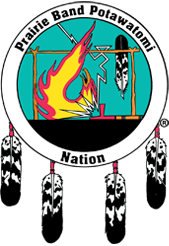April 20, 2016 –
Storm Spotting in Tornado Alley
Severe thunderstorms and tornadoes are a part of life for this area of the country. The National Weather Service does its best to provide local citizens’ status updates on weather conditions in order for you to implement safety precautions and maintain your wellbeing. Weather awareness is especially important in Kansas, where atmospheric conditions can change very rapidly.
On Thursday, April 7, 2016, PBPN personnel along with a handful of community members joined together at the Bingo Hall to take part in a presentation by Chris Sanders from the Topeka National Weather Service office. Sanders presented information on Weather Safety.
The National Weather Service is the only organization across the United States responsible for issuing weather watches and warnings. The organization is composed of 122 offices throughout America. The National Weather Service’s primary vision is to limit threat to life and property.
The NWS provides three major perspectives on weather conditions. Generally they are providing an outlook for the weather. The outlook is the predicted weather for a given location throughout a certain amount of time. The second and more substantial weather information is a watch. A watch is issued when atmospheric conditions are favorable for specific weather phenomena. The third and highest level of information is a warning. Warnings are issued when weather phenomena are actually occurring or emanate.
Watches include: Warnings include:
- Severe Thunderstorm Watch 1. Severe Thunderstorm Warning
- Tornado Watch 2. Tornado Warning
- Flash Flood Watch 3. Flash Flood Warning
A watch indicates it could occur. A warning means it is or will occur shortly. If a warning has been issued, you should seek shelter IMMEDIATELY.
Storm Spotters play a critical role in helping the National Weather Service assess the weather. Storm spotters provide real time critical information known as a “Ground Truth Report.” Some phenomena that should be called in to the NWS include: live tornadoes, funnel clouds, wall clouds, wind gusts greater than 50 mph, or any hail stones greater than 1” (side note: when reporting hail, report the largest stone visible – use a familiar object as a guide, example “golf ball size” hail).
Storm spotters can keep in contact with the National Weather Service through Facebook. The local organization is listed as “US NWS Topeka, KS.” The organization is also on Twitter, the handle is @NWSTopeka and search for #kswx in twitter feeds. They also have a toll free number, 1-800-432-3929.
Sanders also provided an in-depth look at tornadoes. The location of the Prairie Band Potawatomi Common Land and state of Kansas is located in an area nationally termed, “Tornado Alley” due to the large amount of tornadoes that occur within the unique geographical location. The location is unique in that the geography creates the exact weather conditions needed for the creation of a tornado. However, tornadoes can actually occur anywhere and all year round.
Often the greatest threat in a tornado is the flying debris. Many deaths attributed to tornadoes occur due to head injuries which is why taking shelter is extensively stressed. The general rule for sheltering is to go to a basement or storm cellar. If that is not available, an interior room without windows, usually a bathroom, is suggested. The absolute least safe place to shelter during a tornado is in a mobile home. If you live in a mobile home, you must evacuate the premises, even if it is to your vehicle. Vehicles are not a primary target for shelter but if you have no other option then use a vehicle. If you must shelter in a vehicle, turn it on so the air bags will be available to deploy and protect you. If you are travelling and a tornado occurs do not park your vehicle under an overpass.
The best way to stay safe from a tornado is to heed the watches and warnings. Much like fire safety, it is important to create a safety plan and practice it with your family. It is also good practice to keep two or more ways to stay informed on hand. One example is a battery operated weather radio. Another option is using a smart phone app or social media. On a smart phone you can look for WEA, Wireless Emergency Alerts to receive real time messaging.
This spring and summer as the storms roll through, remember to heed the information provided by the National Weather Service. It is for your benefit and the lives of your family members. You can also make a difference in your community by acting as a Storm Spotter and reporting real time weather conditions to the NWS.
Visit www.weather.gov/top for up-to-date weather conditions and information.
